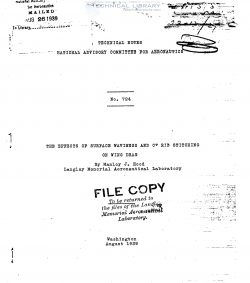naca-tn-724
- Version
- 157 Downloads
- 746.30 KB File Size
- 1 File Count
- November 29, 2016 Create Date
- November 29, 2016 Last Updated
National Advisory Committee for Aeronautics, Technical Notes - The Effects of Surface Waviness and of Rib Stitching on Wing Drag

Surface waviness and rib stitching have been inves-
tigated as part of a series of tests to determine the ef-
fects on wing drag of common surface irregularities. The
tests were made in the K.A.G.A. 8-foot high-speed wind
tunnel at Reynolds Humbers up to 17,000,000.
The results of the tests showed that the waviness
common to airplane wings will cause no serious increase
in drag unless the waviness exists on the forward part of
the wing, where it may cause premature transition or pre-
mature compressibility effects. Waves 3 inches wide and
0.048 inch high, for example, increased the drag l per-
cent when they covered the rear 67 percent of both sur-
faces and 10 percent when they covered the rear 92 per—
cent. A single wave 3 inches wide and only 0.020 inch
high at the 10.5-percent-chord point on the upper surface
caused transition to occur on the wave and increased the
drag 6 percent.
Rib stitching increased the drag ? percent when the
rib spacing was 6 inches; the drag increment was propor-
tional to the number of ribs for wider rib spacings.
About one-third of the increase was due to premature
transition at the forward ends of the stitching.
The N.A.C.A. has recently conducted tests to deter~
mine the effects on wing drag of surface irregularities
common to present-day airplanes. Results showing the ef-
fects of various sizes and arrangements of protruding and
countersunk rivet heads, of spot welds, of several types
of lapped sheet-metal Joints, of imperfections in butted
joints, of surface roughness. and of manufacturing irregu-
larities have been published in reference 1. The present - .
note gives results showing the effect on wing drag of sur— '
face waviness such as occurs on sheet—metal and plywood—
covered wings and of rib stitching such as occurs on fab-
ric-covered wings. The tests were made in the N.A.G.A. -
8-foot high—speed wind tunnel at Reynolds Numbers up to
17,000,000.
| File | Action |
|---|---|
| naca-tn-724 The Effects of Surface Waviness and of Rib Stitching on Wing Drag.pdf | Download |
Comment On This Post